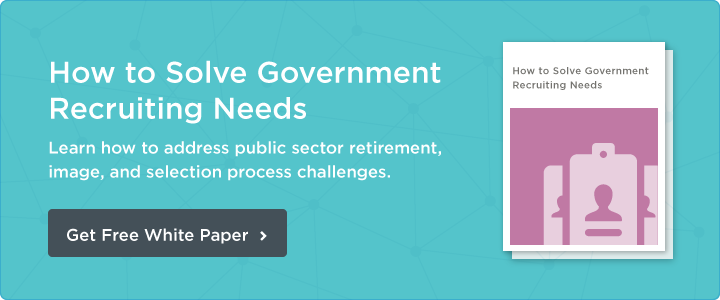Feeling burnt out trying to hire in this competitive job market? Find out how to win top talent despite today’s public sector HR challenges.
Article Highlights
- Details on today’s public sector job market
- How job seekers are changing and what HR can do to adjust
- How to win in a competitive job market
It’s a competitive job market out there. You’ve been posting the same job over and over, yet you're still receiving fewer applications than ever before. Each time you think you’ve finally found the perfect candidate… they turn down your job offer for another opportunity.
Sure, your public sector organization provides a unique value proposition: employees who work for you have the opportunity to spend a meaningful career serving their communities.
But here’s the deal. This value proposition alone isn’t enough in today’s job market. If you’re going to compete with dozens (if not hundreds!) of other employers, you need to think carefully about the benefits you provide job seekers.
So let’s dig a little deeper. Below we’ll provide an overview of the current state of this competitive job market, address public sector HR challenges, and provide insights about how you can find top talent despite them.
Ready? Let’s find out how to win in today’s market.
Public Sector HR Function
To address how to compete in today’s market, first we need to understand exactly what public sector human resource professionals do…
And you already know it’s so much more than just pushing papers (despite what pop culture may have to say about the profession!). Public sector HR functions to:
- Understand and address candidate needs during the hiring process
- Shape organizational culture
- Instill meaning and purpose into every role
As one of the first people a candidate meets, you set the tone for the entire organization. During the hiring process, you take the time to understand candidate needs and write a job description that attracts top talent. Then, you maintain regular communication, answer questions, coordinate schedules, and conduct interviews with job seekers.
If all goes well, your candidate becomes an employee. But your job doesn’t stop there.
You continue to contribute to the employee lifecycle by shaping organizational culture. The table below identifies some (but certainly not all!) of the ways you accomplish this.
| Action |
Contribution to Strong Org Culture |
| Conducting class and comp studies |
|
| Developing and facilitating training |
|
| Maintaining policies |
|
Perhaps most significantly, you instill meaning and purpose into every employee’s job. You provide them with professional development opportunities. You host networking events so employees can connect and create a sense of community. You regularly remind employees about how their roles contribute to the organization as a whole.
So let’s keep the public sector HR function in mind as we continue discussing today’s competitive job market. Remembering the unique and pivotal role you play in shaping employee experience is fundamental to redefining your recruitment strategy.
What Does Today's Public Sector Job Market Look Like?
With your finger on the pulse of so many different facets of your organization, you’re well aware that things in the public sector job market are changing. But you may not have seen the metrics laid out quantitatively yet.
Since 2015, job applications have been on the decline, with the average number of applications per job decreasing by 21% (no wonder you feel like you have a labor shortage!).
And we’ve seen a significant decline in job postings from 2020 to 2021, too. Week 38 of 2021 saw an average of 3.5 applications per job, compared to 6 applications per job in the same week of 2020. This trend is holding for many different roles in the public sector, including healthcare support, transportation and material moving, and personal care and service.
Public Sector HR Challenges: Hiring in a Competitive Market
It’s easy to see why hiring in today’s competitive market is one of the biggest public sector HR challenges. First and foremost, organizations are receiving fewer applications for job openings in general, meaning it's harder to fill positions with top talent.
And since so many public and private organizations are trying to fill roles at the same time, the fact that a public sector hiring process takes three times longer than the private sector puts your organization at a disadvantage.
Which means that one of the best ways to adapt to the changing needs of your applicants (namely how quickly applicants expect to find a new job!) is to speed up your hiring process.
This may look like using software like NEOGOV’s Insight to quickly screen and rank applicants and decrease the time it takes to contact talented applicants. Or it could mean streamlining communication by enabling candidates to self-schedule interviews for whenever works best for them.
No matter how you choose to speed up your hiring process, doing so is fundamental to adapting to job seekers’ changing needs in today’s fast-moving market.
How to Win in a Competitive Job Market
So how else can a public sector organization compete with the private sector given fewer applicants, limited advertisement resources, and slower bureaucratic processes? Fortunately, there are some traits inherent to many public sector jobs that give your organization a leg up over private sectors.
In our 2021 Job Seeker Report, we found that the top three reasons people pursue public sector jobs are:
- Job security
- Meaningful work
- Strong benefits
These three motivations were followed closely by work-life balance. To win in a competitive job market, your organization should focus on these factors when recruiting.
Provide opportunities to do meaningful work
Public sector jobs are inherently meaningful. Without solid waste employees, trash would pile up in the street. Without firefighters, buildings would be destroyed. Without budget analysts, residents wouldn’t know about the programs and services their tax dollars fund.
But sometimes job seekers get stuck in the weeds of a job’s day-to-day and forget to look at the bigger picture of their career paths. So it’s your job to remind them about the contributions your organization makes to communities every single day.
How do you do that?
Well, when writing recruitment ads, emphasize how the role contributes to the community at large. Do the same when speaking with candidates during interviews.
And don’t stop once an employee gets hired! You may consider hosting resident academies where government employees share details about their jobs with residents. Not only does this serve as a recruitment vehicle (you never know when you might have a future public servant in the crowd!) but it also reminds existing employees why their jobs matter.
Job security and opportunity
Having lived through the uncertain times of a pandemic, job seekers crave stability and job security. But people also want the opportunity to grow in their careers.
In particular, individuals in the 18-34 age demographic view opportunities for advancement as a key career motivator. Given that this is a relatively young demographic, many individuals in this age range may also be the ones applying for entry-level positions.
As such, consider how you might discuss long-term career development opportunities when recruiting entry-level employees. This may look like highlighting professional development events that your organization hosts, discussing marketable skills employees will gain within the role, or paying for relevant professional certifications.
Offer competitive benefits
Benefits are yet another important reason people pursue careers in the public sector. As such, human resources should list benefits that the organization offers on all recruitment materials. Competitive benefits may include things like:
- Strong retirement benefits
- Flexible work arrangements
- Unlimited or generous PTO
- Free or low-cost health insurance
And the last thing you want is to lose talent to a neighboring local government! Conducting regular class and comp studies ensures that your organization’s salaries and benefits are keeping up with market trends. NEOGOV’s Insight can be helpful in this regard, as it provides access to a shared library that enables HR professionals to view the job descriptions (including salary ranges) of all participating organizations.
Allow remote work and flexible work arrangements
Flexible work arrangements help promote work-life balance, which is yet another reason people are motivated to pursue public sector jobs. These work arrangements are seen as an incredibly attractive benefit, with 25% of employees being willing to take a 10-20% pay cut in exchange for this flexibility.
Work-life balance is of particular importance for individuals in more technical public sector positions. HR professionals should thus carefully consider how remote work or flexible work arrangements can be used to attract people to public sector roles involving computers, mathematics, healthcare, media, law, and more.
Final Thoughts
Winning in today’s competitive job market requires rethinking how your organization attracts talent. Focusing on the public sector’s inherent strengths, such as its meaningful work, job security, competitive benefits, and flexible work arrangements, is a key way to attract top talent to your organization.
Feeling inspired to take your recruitment strategy to the next level? You can learn even more about how to recruit & retain top talent in the public sector on our blog.

